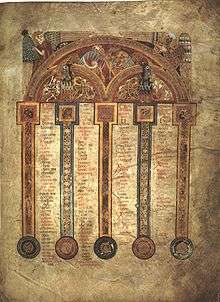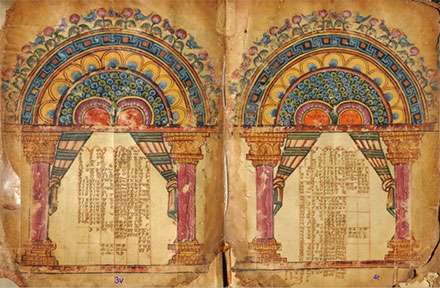Eusebian Canons
Eusebian canons, Eusebian sections or Eusebian apparatus,[1] also known as Ammonian sections, are the system of dividing the four Gospels used between late Antiquity and the Middle Ages. The divisions into chapters and verses used in modern texts date only from the 13th and 16th centuries, respectively. The sections are indicated in the margin of nearly all Greek and Latin manuscripts of the Bible, and usually summarized in Canon Tables at the start of the Gospels (see below). There are about 1165 sections: 355 for Matthew, 235 for Mark, 343 for Luke, and 232 for John; the numbers, however, vary slightly in different manuscripts.[2]


The Canon Tables were made to create a sense of divinity within the reader’s soul, to understand and reflect upon the various colors and patterns to achieve a higher connection with God. [3]
Authorship
Until the 19th century it was mostly believed that these divisions were devised by Ammonius of Alexandria, at the beginning of the 3rd century (c. 220), in connection with a Harmony of the Gospels, now lost, which he composed. It was traditionally believed that he divided the four Gospels into small numbered sections, which were similar in content where the narratives are parallel. He then wrote the sections of the three last Gospels, or simply the section numbers with the name of the respective evangelist, in parallel columns opposite the corresponding sections of the Gospel of Matthew, which he had chosen as the basis of his Gospel Harmony. Now it is believed that the work of Ammonius was restricted to what Eusebius of Caesarea (265-340) states concerning it in his letter to Carpianus (Epistula ad Carpianum), namely, that he placed the parallel passages of the last three Gospels alongside the text of Matthew, and the sections traditionally credited to Ammonius are now ascribed to Eusebius, who was always credited with the final form of the tables.
The Eusebian Tables
_-_Canon_Table_Page_-_Google_Art_Project_(6915047).jpg)
The Harmony of Ammonius suggested to Eusebius, as he himself tells us in his letter, the idea of drawing up ten tables (kanones) in which the sections in question were so classified as to show at a glance where each Gospel agreed with or differed from the others. In the first nine tables he placed in parallel columns the numbers of the sections common to the four, or three, or two, evangelists; namely: (1) Matt., Mark, Luke, John; (2) Matt., Mark, Luke; (3) Matt., Luke, John; (4) Matt., Mark, John; (5) Matt., Luke; (6) Matt., Mark; (7) Matt., John; (8) Luke, Mark; (9) Luke, John. In the tenth he noted successively the sections special to each evangelist.
| Table # | Matthew | Mark | Luke | John |
|---|---|---|---|---|
| In Quo Quattor | ||||
| Canon I. | Yes | Yes | Yes | Yes |
| In Quo Tres | ||||
| Canon II. | Yes | Yes | Yes | |
| Canon III. | Yes | Yes | Yes | |
| Canon IV. | Yes | Yes | Yes | |
| In Quo Duo | ||||
| Canon V. | Yes | Yes | ||
| Canon VI. | Yes | Yes | ||
| Canon VII. | Yes | Yes | ||
| Canon VIII. | Yes | Yes | ||
| Canon IX. | Yes | Yes | ||
| In Quo Matth. Proprie | ||||
| Canon X | Yes | |||
| In Quo Marc. Proprie | ||||
| Canon X | Yes | |||
| In Quo Luc. Proprie | ||||
| Canon X | Yes | |||
| In Quo Ioh. Proprie | ||||
| Canon X | Yes | |||
The usefulness of these tables for the purpose of reference and comparison soon brought them into common use, and from the 5th century the Ammonian sections, with references to the Eusebian tables, were indicated in the margin of the manuscripts. Opposite each section was written its number, and underneath this the number of the Eusebian table to be consulted in order to find the parallel texts or text; a reference to the tenth table would of course show that this section was proper to that evangelist. These marginal notes are reproduced in several editions of Tischendorf's New Testament.
Eusebius's explanatory letter to Carpianus was also very often reproduced before the tables.
Illuminated Canon Tables

The tables themselves were usually placed at the start of a Gospel Book, and in illuminated copies were placed in round-headed arcade-like frames of which the general form remained remarkably consistent through to the Romanesque period. This form was derived from Late Antique book-painting frames like those in the Chronography of 354. In many examples the tables are the only decoration in the whole book, perhaps other than some initials. In particular, canon tables, with Evangelist portraits, are very important for the study of the development of manuscript painting in the earliest part of the Early Medieval period, where very few manuscripts survive, and even the most decorated of those have fewer pages illuminated than was the case later.
See also
Notes
- D. C. Parker, An Introduction to the New Testament Manuscripts and their Texts, Cambridge University Press, 2008, p. 24.
- Bruce M. Metzger, Manuscripts of the Greek Bible: An Introduction to Palaeography, Oxford: Oxford University Press, 1991, p. 42. ISBN 978-0-19-502924-6
- Nersessian, Vrej (2001). The Bible in the Armenian Tradition. London: The British Library. pp. 70&74. ISBN 0-89236-640-0.
References
